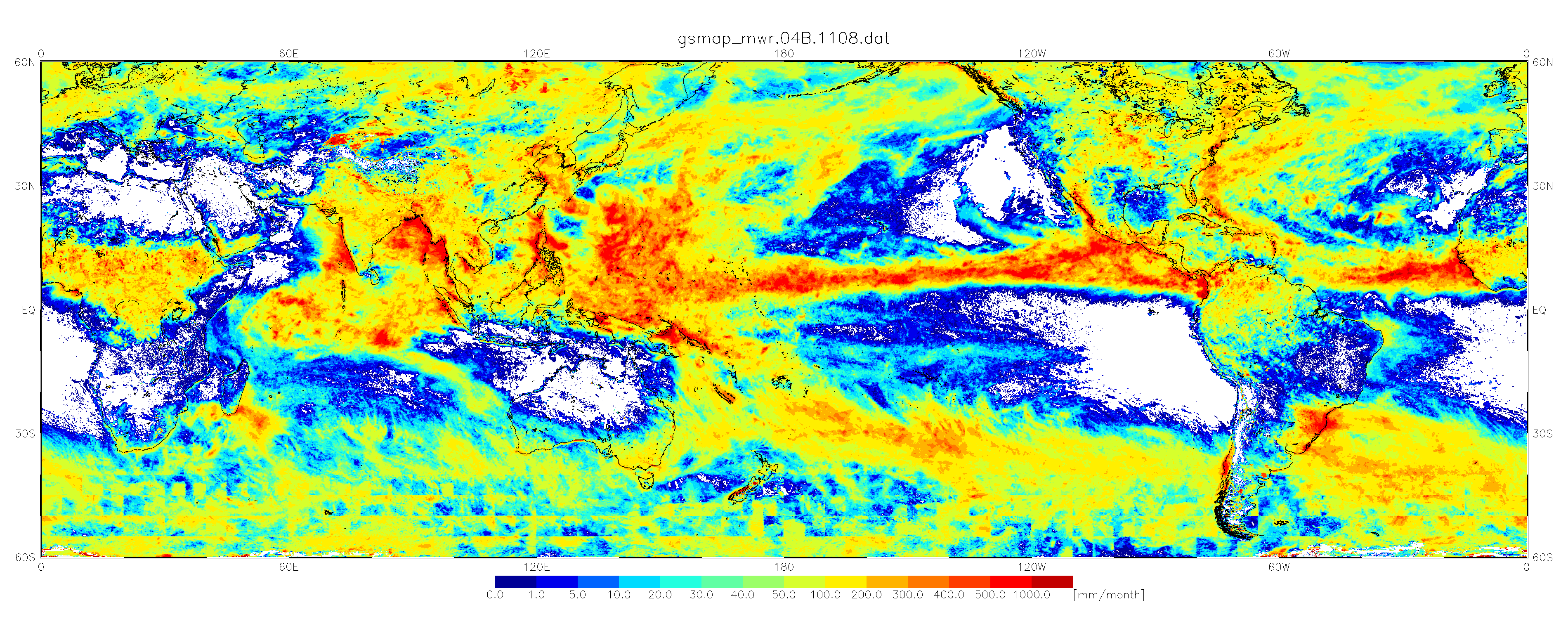Research of Precipitation Measuring Mission
JAXA Supercomputer System Annual Report April 2018-March 2019
Report Number: R18ER1400
Subject Category: Space Technology
- Responsible Representative: Naoto Matsuura, Earth Observation Research Center
- Contact Information: Takuji Kubota(kubota.takuji@jaxa.jp)
- Members: Tomohiko Higashiuwatoko, Takeshi Masaki, Tomoyuki Nomaki, Yoriko Arai, Takuji Kubota
Abstract
Calculation of the global rainfall map derived from Tropical Rainfall Measuring Mission (TRMM) during a period from 2000 to 2014 using the GSMaP algorithm (V07).
Checks of consistency between the TRMM Precipitation Radar (PR) algorithm (V8) and the GPM/DPR algorithm (V06) with long-term observation data.
Reference URL
Please refer to https://www.eorc.jaxa.jp/TRMM/index_e.htm .
Reasons for using JSS2
The JSS2 is necessary for calculation of the long-term data which consists of multiple satellites and sensors for the precipitation measurement with earlier computational times for algorithm evaluations, improvements, and long-term production. Because of the complexity of the processing algorithms, strict business progress management, emergency response, detailed user response by the operation side, etc. are required. When we do not use the JSS2, it can be said that reprocessing in a short period cannot be achieved.
Achievements of the Year
To develop of the level 2 algorithm and the latent heat algorithm of both TRMM PR version 8 products and GPM DPR version 06 products, we conducted a long-term processing. The total processing period was 90 months.
Fig.1 shows time series of the rain rate of both TRMM PR and GPM DPR at the Earth’s surface. The time series was smooth over the all periods in version 8 of TRMM PR and version 06 of GPM DPR, while there was a gap of rain rate in version 7 of TRMM PR and version 05 of GPM DPR.
A processing time was shortened. For instance, the processing, which took about 360 hours for a month, was shortened to about 9 hours by using JSS2. It accelerated the cycle between the data evaluation and the algorithm development, and it led to the release of the climate product with homogeneous data quality.
In GSMaP, which has recently expanded the number of users, reprocessing of observation data over a long-term period of 14 years (2000 to 2014) was conducted with the version 7 algorithm. The reprocessing shortened a preparation time for product release to the public.
Fig. 2 shows an example of monthly accumulated rain rates of the GSMaP.

Fig.1: Time series of the rain rate of both TRMM PR and GPM DPR at the Earth’s surface. The left panel shows over-land results and the right panel shows over-ocean results.
Publications
– Peer-reviewed papers
1. K. Kanemaru, T. Kubota, and T. Iguchi, 2019: Improvements in the beam-mismatch correction of Precipitation Radar data after the TRMM orbit boost, IEEE Trans. Geosci. Remote Sens, in revision.
2. T. Mega, T. Ushio, T. Matsuda, T. Kubota, M. Kachi and R. Oki, 2019: Gauge-Adjusted Global Satellite Mapping of Precipitation, IEEE Trans. Geosci. Remote Sens, in press, doi: 10.1109/TGRS.2018.2870199.
– Non peer-reviewed papers
1. T. Kubota, K. Aonashi, T. Ushio, S. Shige, Y. N. Takayabu, M. Kachi, Y. Arai, T. Tashima, T. Masaki, N. Kawamoto, T. Mega, M. K. Yamamoto, A. Hamada, M. Yamaji, G. Liu and R. Oki, 2019: Global Satellite Mapping of Precipitation (GSMaP) products in the GPM era, Satellite precipitation measurement, Springer, accepted.
2. Y. Kuleshov, T. Kurino, T. Kubota, T. Tashima, P. Xie, 2019. WMO Space-based Weather and Climate Extremes Monitoring Demonstration Project (SEMDP): First outcomes of regional cooperation on drought and heavy precipitation monitoring for Australia and South-East Asia. Chapter in book RAINFALL (Edited by John Abbot). ISBN 978-1-78984-735-2, accepted.
3. Y. Kuleshov, K. Inape, A. B. Watkins, A. Bear-Crozier, Z.-W. Chua, P. Xie, T. Kubota, T. Tashima, R. Stefanski, T. Kurino, 2019. Climate Risk and Early Warning Systems (CREWS) for Papua New Guinea. Chapter in book RAINFALL (Edited by John Abbot). ISBN 978-1-78984-735-2, accepted.
– Oral Presentations
1. T. Kubota et al. Current Status of the Global Precipitation Measurement (GPM) Mission in Japan, AOGS 2018@Honolulu on June 2018
2. R. Oki and T. Kubota, JAXA TRMM/GPM Program Status, 2018 PMM Science Team Meeting, Phoenix, Arizona, October 2018.
3. T. Kubota et al, Recent progress of the Global Precipitation Measurement (GPM) mission in Japan, 9th IPWG Workshop, Seoul, 5-9 November, 2018
– Web
JAXA Global Rainfall watch
https://sharaku.eorc.jaxa.jp/GSMaP/index.htm
EORC TRMM
https://www.eorc.jaxa.jp/TRMM/index_e.htm
Usage of JSS2
Computational Information
- Process Parallelization Methods: N/A
- Thread Parallelization Methods: N/A
- Number of Processes: 1
- Elapsed Time per Case: 24 Hour(s)
Resources Used
Fraction of Usage in Total Resources*1(%): 0.20
Details
Please refer to System Configuration of JSS2 for the system configuration and major specifications of JSS2.
| System Name | Amount of Core Time(core x hours) | Fraction of Usage*2(%) |
|---|---|---|
| SORA-MA | 0.00 | 0.00 |
| SORA-PP | 172,762.64 | 1.38 |
| SORA-LM | 2,174.60 | 1.01 |
| SORA-TPP | 51,030.07 | 3.73 |
| File System Name | Storage Assigned(GiB) | Fraction of Usage*2(%) |
|---|---|---|
| /home | 52.45 | 0.05 |
| /data | 69,503.82 | 1.23 |
| /ltmp | 10,742.19 | 0.92 |
| Archiver Name | Storage Used(TiB) | Fraction of Usage*2(%) |
|---|---|---|
| J-SPACE | 20.88 | 0.73 |
*1: Fraction of Usage in Total Resources: Weighted average of three resource types (Computing, File System, and Archiver).
*2: Fraction of Usage:Percentage of usage relative to each resource used in one year.
JAXA Supercomputer System Annual Report April 2018-March 2019



